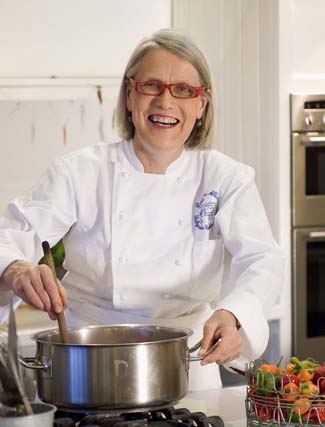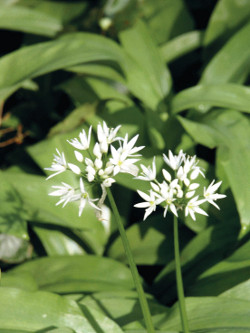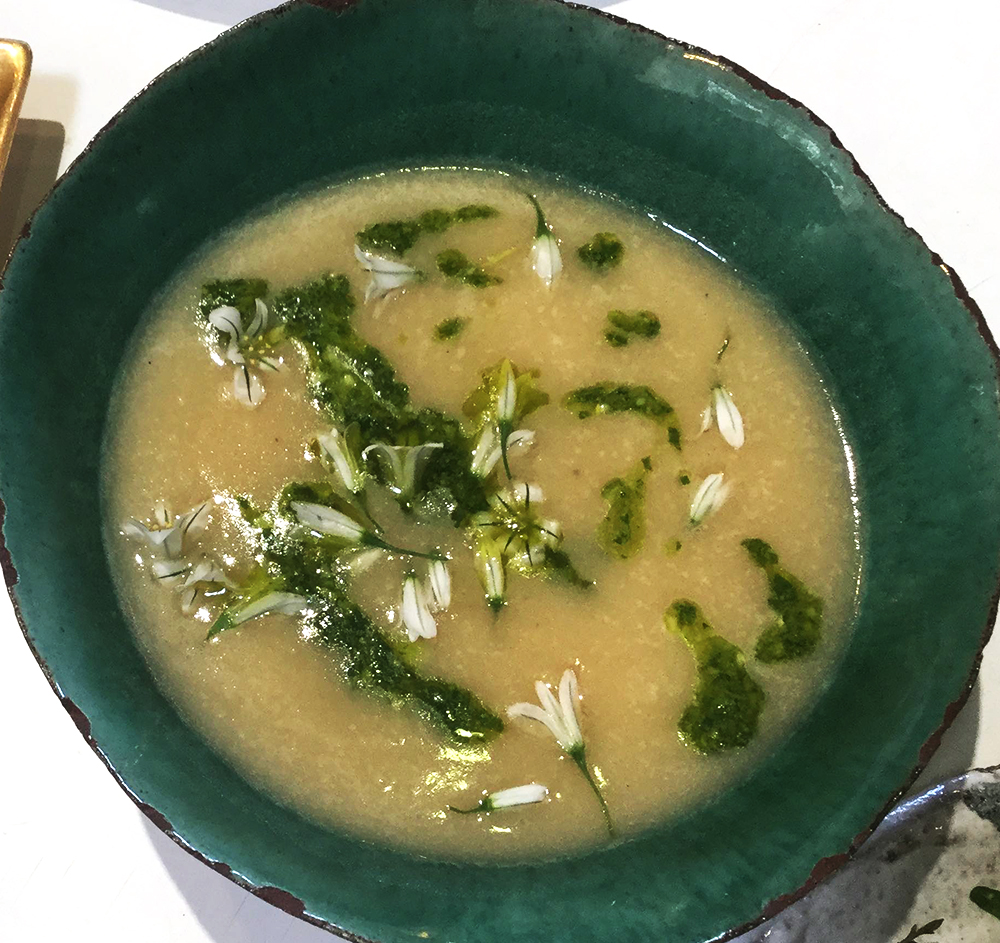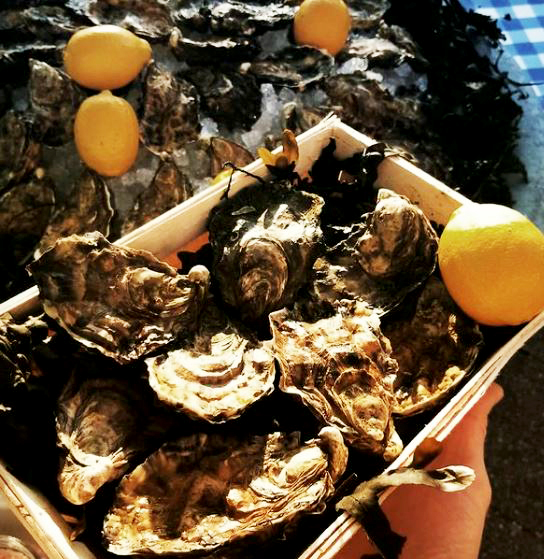The Darina Allen Column - In Praise of St Brigid
 The beginning of February is very special in the Irish calendar and - although the meteorological beginning of spring is a month later - La Feile Bride, the feast day of Saint Brigid on 1st February, marks the start of the new season of seed sowing, when nature begins to spring back into life and hope is renewed. All the more reason to celebrate this year...
The beginning of February is very special in the Irish calendar and - although the meteorological beginning of spring is a month later - La Feile Bride, the feast day of Saint Brigid on 1st February, marks the start of the new season of seed sowing, when nature begins to spring back into life and hope is renewed. All the more reason to celebrate this year...
Saint Brigid's Day also coincides with the start of the festival of Imbolg, one of the four major 'Fire' festivals. The other three festivals in Irish folklore are Beltaine, Lughnasadh, and Samhain. Imbolc/ Imbolg is celebrated by Neopagans with a variety of Celtic rituals.
Surely it’s high time to elevate St Brigid to her rightful place, to give her equal billing with Saint Patrick as our female patron saint and to declare St. Brigid's Day a national holiday.
Depending on who or what you read, St. Brigid is the patron saint of cattle farmers, dairy maids, bee keepers, midwives, babies, blacksmiths, sailors, boatmen, fugitives, poets, poultry farmers, scholars, travellers. For me, Bridget was the original feminist, a trail blazer, a strong woman's voice in a male dominated world, a feminine role model, a force to be reckoned with.... She was one busy saint!
She is still widely venerated and many lovely traditions endure around the country. Possibly best known is the tradition of weaving St.Brigid's Crosses from reeds. Bridget, we are told, was the founder of the first Irish monastery in Kildare in the fifth century. According to the legend, she was called to the bedside of a dying pagan chieftain. While she watched over him, she bent down, picked up some rushes from the floor and wove a cross to explain the Christian story, whereupon the chieftain was promptly converted to Christianity.
Just as the shamrock is associated with St. Patrick, the little woven cross is associated with St Brigid. Typically, it has four arms with a woven square in the centre but three armed crosses are traditional in some counties as explained to me by Saint Brigid's Day cross maker extraordinaire Patricia O'Flaherty, whom I met at La Feile Bride celebrations at the Irish Embassy in London some years ago.
As I write this, I particularly remember Eileen Cowhig, a wonderful local lady who came to the Ballymaloe Cookery School for years to pass on the tradition of how to weave the St. Brigid's Cross to students from all over the world. We would then hang a newly woven cross in both the dairy and the hen house to bless the hens and to protect our little herd of Jersey cows who produce the most delicious rich milk. She died last year and is fondly remembered by all of us.
 The St.Brigid's Cross was proudly chosen by newly launched Telifis Eireann in 1961 as its logo and continued until 1995 when it was dropped in favour of 'a clean striking piece of modern design'.
The St.Brigid's Cross was proudly chosen by newly launched Telifis Eireann in 1961 as its logo and continued until 1995 when it was dropped in favour of 'a clean striking piece of modern design'.
Another endearing tradition is to leave a piece of cloth, a scarf or a ribbon on a bush outside on St. Brigid's Eve to be blessed by the saint as she passes. This is known in Irish Folklore as Bratog Brid and will cure headaches and sore throats. In Kerry, particularly, a Bridog doll, sometimes woven from corn was taken from house to house as this refrain was recited:
'This is Brigid dressed in white,
Give her something for the night,
She is deaf, she is dumb,
Give her money if you have some,' ( Ref: duchas.ie)
Over the past decade, St. Brigid's Day celebrations have been gathering momentum around the globe. Since 2018, the achievements of Irish women from all walks of life have been celebrated on La Feile Bride at the Irish Embassy in London. This year, due to the COVID-19 pandemic, many of the celebrations have gone online. From a virtual afternoon tea in Luton to a women's festival of female literary creativity in Berlin, and a weeklong virtual event in Vancouver. So, how about special foods to mark St. Brigid's Day........
Colcannon is a traditional favourite..... At this time of the year, I often make it with parsnips and potatoes mixed with kale - a tip from the late Gay Byrne who insisted that it was the Dublin way of making it and the way his mother always made it. I am indebted to Gay for sharing this and remember him fondly every time we enjoy it.
 Look out for the early wild garlic, tri cornered leek or snowbells (allium triquetrem) which romps along the roadsides at this time of the year. It resembles white bluebells but has a distinct garlic smell when the thin leaves are rubbed between the fingers. It's also delicious added to colcannon, but here I am sharing my brother Rory O'Connell's recipe for Wild Garlic broth, I could imagine St Brigid might have made a similar version at this time of the year. After all, it's likely that she would have been a knowledgeable forager and was no doubt well acquainted with both the flavour and medicinal benefits of many wild plants.
Look out for the early wild garlic, tri cornered leek or snowbells (allium triquetrem) which romps along the roadsides at this time of the year. It resembles white bluebells but has a distinct garlic smell when the thin leaves are rubbed between the fingers. It's also delicious added to colcannon, but here I am sharing my brother Rory O'Connell's recipe for Wild Garlic broth, I could imagine St Brigid might have made a similar version at this time of the year. After all, it's likely that she would have been a knowledgeable forager and was no doubt well acquainted with both the flavour and medicinal benefits of many wild plants.
Perhaps you too can have a virtual afternoon tea and celebrate and raise awareness of our female patron saint.
Dublin Parsnip Colcannon
Several Dubliners have spoken to me about a parsnip colcannon that 'the Mammy used to make'. At Hallowe'en, thrupenny or sixpenny bits were sometimes hidden in the colcannon for the children to find. The proportion of parsnips to potato varied.
Serves 8 (approximately)
450g (1lb) old potatoes e.g. Golden Wonders or Kerr's Pinks
450g (1lb) parsnips
450g (1lb) curly kale
250–300ml (9–10fl oz) creamy milk
2 tablespoons approx. chopped scallions
55g (2oz) approx. butter
salt and freshly ground pepper
Scrub and peel the potatoes and parsnips, put them into a saucepan, cover with cold water, add a good pinch of salt and bring to the boil. When the potatoes and parsnips are cooked, strain off the water, replace the lid on the saucepan, put on a gentle heat and allow to steam for a few minutes, then mash.
While the potatoes and parsnips are cooking, bring a pot of well salted water tothe boil, remove the central rib from the kale and cook the leaves until tender. Drain and chop finely.
When the potatoes are almost cooked, put on the milk and bring to the boil with the scallions. While the potatoes and parsnips are still warm, stir in the chopped kale and beat in enough boiling milk to make a fluffy purée. (If you have a large quantity, use the bowl of a food mixer and beat with the spade.) Add the butter and taste for seasoning. Stir over the heat and serve immediately in a hot dish with the butter melting in the centre.
Note: Colcannon may be prepared ahead and reheated later in a moderate oven (180ºC/350ºF/gas mark 4) for about 20–25 minutes.
 Rory O'Connell's Wild Garlic Leaf and Flower Broth
Rory O'Connell's Wild Garlic Leaf and Flower Broth
The key to the success of this recipe is the addition of the wild garlic to the broth just a few minutes before you are going to eat it. This way the garlic will still be bright green in colour and vibrant in taste when it arrives at the table. Some times the little flowers, which I urge you to use, will float to the surface of the hot broth and sit there like little water lilies or lotus flowers. Now that's a bonus. Serves 6
The ingredients: The wild garlic when in season is readily available for those who live in the countryside and for urban dwellers is increasingly available in vegetable shops and farmers markets. Every part of the two different varieties can be used, bulbs below the ground and leaves and flowers above.
An optional addition of grated parmesan cheese is delicious here. Allow your guests to sprinkle a light dusting on each bowl of poured soup rather than you adding it to the cooking pot. It will taste sweeter and fresher this way. One teaspoon of parmesan is plenty on each serving.
50g butter
175g potatoes, peeled and cut into neat 1cm dice
175g onions, peeled and finely chopped into ½ cm dice
2 cloves of garlic, peeled and crushed to a paste
1.2l chicken stock
Salt and pepper
600ml of finely chopped garlic leaves, tightly packed into the measure
50ml garlic flowers.
Melt the butter in a heavy saucepan and allow to foam. Add the potatoes, onions and crushed garlic. Coat in the butter and season with salt and pepper. Cover with a butter wrapper or greaseproof paper and cover with a tight fitting lid. Cook on a very low heat to allow the vegetables to sweat gently until barely tender. This will take about 10 minutes. Don't overcook and allow the diced potato to collapse. Add the stock, stir gently and bring to a simmer and cook gently for a further 10 minutes. The broth should be barely bubbling. If it cooks too fast at this stage, the delicacy of flavour of the chicken stock will be lost. Taste and correct seasoning. This is the base and can be put aside until later.
To finish, bring the base back to a simmer. Add the garlic leaves and allow to just wilt. This will only take a couple of minutes. Taste and correct seasoning. Finally sprinkle in the flowers, watch and marvel as they float on the surface. Serve immediately.
IN SEASON

Irish oyster fishermen need and would deeply appreciate our support because the restaurant industry and their overseas markets have been so severely affected by the Covid 19 pandemic and the Brexit delays at the ports. Oysters are delicious and a brilliant source of zinc and vitamin D (both frequently cited as helpful to the immune system in protecting against Covid-19). There are two main varieties, the indigenous Irish oyster, Ostrea edulis (in season September-April, when there’s a ‘r’ in the month) and Crassostrea gigas also referred to as Pacific, Portuguese, or Rock Oysters (all year). If you can get your hands on some large gigas oysters, there's a super variety of cooked oyster recipes for them. Buy from English Market in Cork City or contact oyster producers around the country, eg Harty's in Dungarvan, Kelly's in Galway, Irish Premium Oysters.... Many will courier a panier of fresh oysters direct to your door overnight.
Wild Garlic
So love that moment when I suddenly realise that – Wow, winter is over. One can practically hear the excitement underneath the ground. Rhubarb and chives are pushing their way up through the soil, everything is stirring. We've already found some wild garlic to add to salad and flavoured butters – so how about a bit of foraging this week. There are two varieties allium ursinum or ramps, a broad leaved bulbous plant which grows in moist woodland, and allium triquetrum also known as three cornered leeks which often grows along the roadside verges. The latter has a flower that resembles 'white' blue bells, and pointy narrow leaves. I find that the leaves of allium ursinum are best for wild garlic pesto so wait a couple of weeks for those.
Ballymaloe Cookery School Live Online Classes
We've been having lots of fun and getting a brilliant response to our online classes. So why not get creative and join us for a cooking session during these strange times from the comfort of your own home.....Over the coming few weeks Rory O'Connell, Rachel and myself will continue our series of cookery demos , cookalongs and fireside chats to keep you entertained and active in the kitchen. For information on our annual membership or individual classes check out www.ballymaloecookeryschoolonline.ie





There are currently no comments
Leave a comment
Not a member? Register for your free membership now!
Or leave a comment by logging in with: